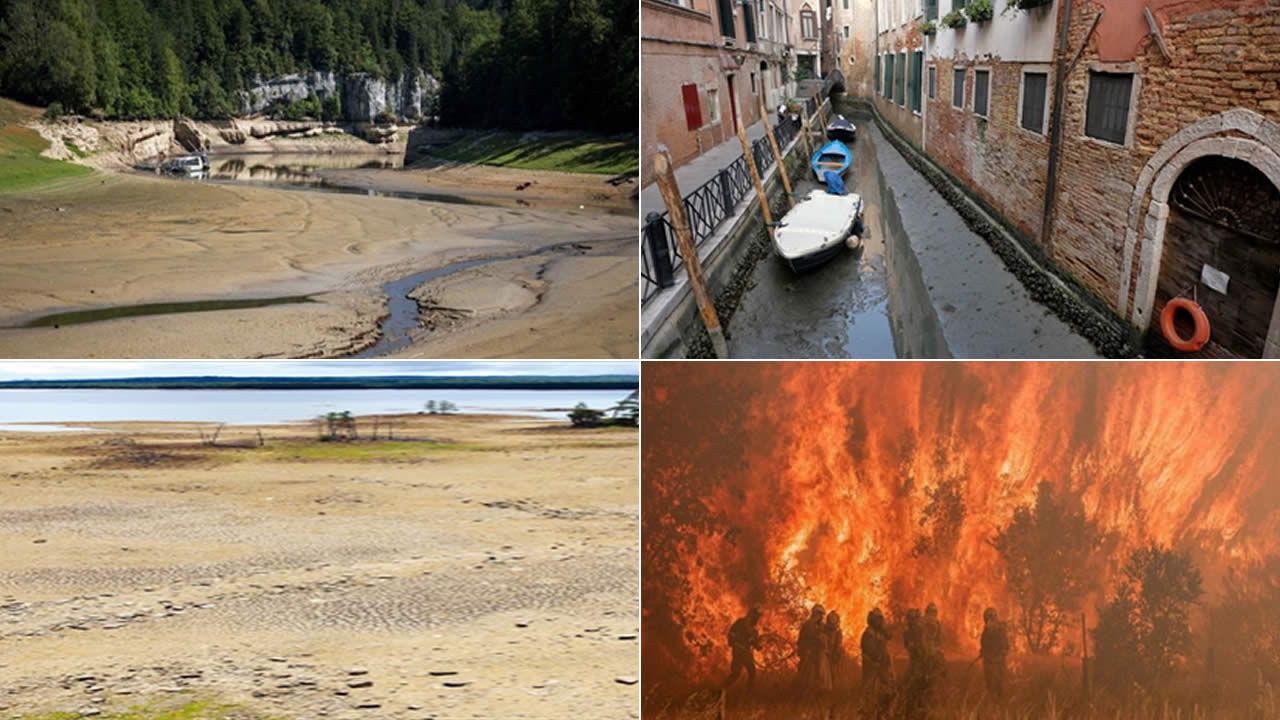
Scientists have been advocating for years now that weather events around the world are getting worse.
Are recent occurrences yet more warning signs, a wake-up call of things to come if we continue to be complacent?
Last year saw an unprecedented number of fires caused by intense heat and high temperatures in various parts of the world. The situation exacerbated by lack of rainfall leading to serious droughts. Scientists believe these are happening as a result of human interference. It is also reported that this will become a frequent occurrence unless we change our ways and take actions urgently.
RECENT WEATHER EVENTS AROUND THE WORLD.
According to NASA Global Climate Change, Earth’s climate has changed throughout its history but, the current warming is happening at a rate not seen in the past 10,000 years. Many of the Scientific research are pointing to the effects of climate change causing global temperature rise resulting to severe droughts, raging fires, melting ice sheets, rising sea levels, flash floods, all evidence of a warming planet.
It has been reported on social media that the northern hemisphere suffered one of its worst droughts last summer and scientists believe that this was made “at least 20 times more likely” by human-induced climate change. The continent of Europe faced one of its worst droughts in 500 years the BBC reported. Last Summer a combination of record temperatures and low rainfalls caused severe droughts and rivers to dry in countries like Germany, UK and France to name but a few. Wildfires rage and crops failed in Spain, Portugal and Italy . The situation was made worse by the Ukraine war and high food prices, adding to the miseries and sufferings of millions who were already making huge sacrifices by cutting back. The period between June and August 2022 was the hottest on record. Europe has been through droughts in the past, but recent years have seen increasingly hot summers with many high temperatures setting new records. According to Dr Fred Hattermann, of the Potsdam Institute for Climate Impact Research, last year’s drought was the worst in hundreds of years. He said that "It's not just less rain, it's also that it's got much warmer, so the overall soil moisture has decreased." Scientists believe that Europe will continue to experience more frequent and persistent droughts. The dry conditions last year affected agriculture, transport and energy generation the repercussions of which are still unfolding.
On the other side of the pond- USA, the American south west experienced its most extreme drought conditions in 1,200 years. The Guardian newspaper reported that the region was experiencing a “megadrought” and that Lake Mead and Lake Powell “are at record low levels and steadily shriveling” and “wildfires now spark all year-round as parched forests and grasslands are more primed than ever to burn”.
China. Reuters, August 26, 2022, reported that the 2022 drought, which mainly impacted China’s Sichuan province, offered an uncomfortable preview of what the future could bring if water supplies continue to run dry: Low reservoir levels slashed hydroelectricity output, which in turn forced power rationing to major industrial consumers such as metals and battery producers and electronics assemblers. A prolonged multi-year drought would have exponentially larger impacts across global grain, energy and industrial materials markets due to water-driven and electricity-caused supply chain disruptions within China it reported. Billions of people worldwide would be affected in ways worse and potentially longer-lasting than the impacts of the COVID-19 pandemic and the ongoing war in Ukraine.
Argentina faced persistent drought threatening crops especially soybeans but was played down by the authorities in order not to sound alarmist. Even the cattle sector was being affected with an increasing rate of animal mortality. Soya, of which Argentina is the world's largest exporter (in the form of flour and oil), the forecast of 48 million tons for the Future strategy could be limited to 41 million tons in the best case, 35.5 million in a low case, according to reports.
Scientists have also found that the deadly South Asian heatwave was made 30 times more likely by the climate crisis and that the intense rainfall, which caused devastating floods across Pakistan, was made 50% worse by global warming. The country saw continuous rainfall for two months. In April, last year Pakistan also experienced a different extreme: record-breaking heat, with temperatures reaching over 40 degrees Celsius. On one day, the country recorded one of the highest ever temperatures, 49 degrees Celsius. These temperatures have also made it harder for flood water to be absorbed into the baked hard ground.
The 2022 monsoon rainfall in Pakistan was nearly three times higher than the 30-year average and rains and consequent flash floods continued throughout July and August taking months for the water to subside. The British Red Cross reported that the record-breaking floods killed over 1,700 people and 1.2 million livestock. Over 7.9 million people displaced. The impact was unimaginable. Livelihoods have been destroyed after two months of continuous rainfall, and people were left without shelter, food, clean water, and toilet facilities.
Earlier this year, The UNICEF reported that nearly 4 million children were still living near contaminated and stagnant flood waters, risking their survival and wellbeing. Frail, hungry, children are fighting a losing battle against severe acute malnutrition, diarrhoea, malaria, dengue fever, typhoid, acute respiratory infections, and painful skin conditions. As well as physical ailments, the longer the crisis continues, the greater the risk to children’s mental health. Meanwhile, hundreds of thousands of homes and many public health facilities, water systems and schools have been destroyed or damaged. The water in some areas of the country has receded, but it's estimated that 25 per cent of the country is still under water.
Extreme weather events are happening more frequently all over the world, putting more and more people in danger. Prof Maarten van Aalst, director of the Red Cross Red Crescent Climate Centre said: “Climate change is really hitting us hard, not just in poor countries like Pakistan, but also in some of the richest parts of the world, like west central Europe, that had been considered less vulnerable. It’s playing out in front of our eyes even faster than we might have expected.”
In parts of Africa, deadly rainfall in 2022 was made ‘80 times more likely’ by climate change it was reported. Countries, such as South Sudan, Mauritania and Senegal, experienced severe flooding. Many parts of southern Africa have also experienced much higher than normal levels of rainfall.
On 16 November 2022 The Guardian Newspaper reported that heavy rain was behind devastating flooding in Nigeria, Niger and Chad and made about 80 times more likely by the climate crisis. The floods that hit the region between June and November last year were among the deadliest on record. Hundreds of people were killed, 1.5 million were displaced and more than 500,000 hectares of farmland was damaged.
A study, by an international team of climate scientists, part of the World Weather Attribution (WWA) group, used weather data and computer models to compare the likelihood of the heavy rain in today’s heated world versus a world without global heating. Such rain would have been extremely rare without human-caused heating, they found, but is now expected once a decade.
More recently, floods due to heavy rainfall in South Africa caused widespread damage to crop and power supply. Many businesses suffered because of the daily power cuts. The president- Cyril Ramaphosa had to declare a national state of disaster and had to invoke the national disaster act to enable the government to use additional powers to bypass restrictions under current law, including the procurement and delivery of goods and services. Malaysia and Indonesia too suffered from flash floods and landslides due to heavy rainfall causing widespread disruptions.
Closer to home- MAURITIUS, is considered to be one of the most vulnerable countries to climate change and one of the most exposed to natural hazards due to its geographical location in an active tropical cyclone region. In February this year it was hit by cyclone – Freddy, which caused some damage on its path but, the consequences could have been much worse according to some observers. The cyclone started near Australia, travelled across the southern Indian Ocean hitting Reunion, Madagascar, Mozambique and more recently Malawi, which was badly affected. It is reported at least 522 died, 438 in Malawi, 67 in Mozambique and 17 in Madagascar. The full extent of the death toll and damage will only come to light once assessments have been concluded. Scientists say that human-caused climate change has worsened cyclone activity, making them wetter, more intense and more frequent.
The threat to our environment and way of life due to effects of global warming is real and we can see them unfolding in front of our eyes. Towards the latter part of 2022, after weeks of dry weather and lack of rainfall, brought about likely by climate change, water levels in all reservoirs reached critical levels. Meteorologists downplayed the situation citing summer rains, which were delayed. The water level in the island's seven reservoirs dropped to critical levels, giving cause for serious concern to the Central Water Authority (CWA) and consumers.
The CWA had to warn consumers that if the situation continued and that rain did not arrive soon, they will bring even more drastic cuts in order to manage the dwindling supply.
The water shortages in the reservoirs became the subject of a high-level meeting chaired by The Prime Minister Pravind Jugnauth to assess the water situation and to review the strategy to be adopted by the water authority should the situation deteriorate further. Droughts have serious consequences. They affect crops, livelihoods, and not to mention other associated problems, which have knock on effects on the economy.
To the relief of all concerned, however heavy rain did finally arrive toward the end of 2022. The water levels in the reservoirs recovered somewhat but, still not at full capacity. The heavy rain brought much needed relief but, came with a twist- flash floods, which caused widespread disruptions. They affected, homes, crops and businesses. The country suffered from more intense rainfall in March this year, which caused flooding in many areas. It came only a few months after last year’s flooding. These events are becoming more likely due to La Nina weather phenomenon, which is associated with increased rainfall. Also, this yo-yo effect where the island lurches from drought to deluge in a short space of time is a phenomenon likely caused by human-induced climate change. The devastating floods are becoming the new normal and we will have to get used to it and adapt fast.
The country has had flash floods before- (2013) that caused widespread damage to infrastructure, even a few fatalities due to drowning but, these events are becoming more frequent and intense. In 2021, an unprecedented 408 mm rainfall in 24 hours was recorded in the south east region of the island, which resulted in acute flash floods putting life at risks, damage to infrastructure as well as property. Mauritius is highly vulnerable to the adverse impacts of climate change with key sectors such as agriculture, coastal zone, fisheries, marine environment and water being at risk. The frequency of storms reaching at least tropical cyclone strength has also increased.
Climate projections for Mauritius are also concerning. It is reported that the projected reduction in rainfall and an increase in evapotranspiration may reduce agricultural production by as much as 15 to 25 % by 2050. With a decrease in rainfall of 10 to 20 % and a temperature increase of 2 degree Celsius, sugar yield is expected to decline by one half to two thirds. It is also estimated that in the next 40-50 years, 50% of our beaches will disappear and the impact of the tourism industry will be catastrophic.
The government will have to be more pro-active and incorporate greater resilience in its future strategies, such as, better warning systems, giving people more time to take action during flooding, potentially saving lives. Advance warning and pre-planning can significantly reduce the impact of flooding. Some of the past predictions by the Met Office have been a hit and miss affair with serious consequences despite their modern technological radar facilities. So, it will need to step up and do more diligence in its services- observation, transmission and processing of weather data accurately going forward.
What is troubling is that a lot of our environment has been defaced and ruined because in the past there have been a lack of proper planning control by the authorities in terms of building constructions. It is all about influence and who you know in order to land a building permit certificate. Nowadays, in the interest of conveniency, a lot of our residential green spaces have been turned into impervious concrete and decking spaces so, the stormwater runs off into sewers. Every time we have intense rainfall, the deluge can’t escape naturally into the ground. The existing and ill-design drains just can’t cope with the volume of water that escapes through roads, causing havoc to homes, business and widespread disruptions to life. All future builds should by law take account of flooding risks and constructed above ground level to prevent flood damage.
Water- A precious resource, the giver of life, yet we take it so much for granted…. ‘waste not, want not’!
It is reported every day, Mauritius loses some 200 million liters of water because of leaks and poor conditions of the CWA infrastructure. In this day and age and with our modern technological advancement it is hard to comprehend why the authorities are dragging their feet instead of investing in an infrastructure network, which is sustainable and fit for purpose. It has been neglected for many years and it is high time adequate investment is pumped into renovating the old and decrepit grid. Water is a valuable commodity and is essential for life so, ‘waste not, want not’, we should be doing all in our powers to preserve it and eliminate waste. This should be a matter of priority for the government. The country spends billions on projects every year and some have turned out to be white elephants. The money could have been better spent on necessary, and more vital projects, such as the water network system, that will improve the quality of life for all.
It is reported that the CWA are in the process of engaging with foreign experts to look at this water waste scandal, which has plagued the country for years. We will not see the findings and report any time soon as it will take a few years. Let’s hope that this is not yet another grandiose fact-finding exercise and a waste of time and tax-payers money. In the meantime, it is business as usual, the waste goes on and the CWA continues to put plasters over the leaks.
The problem is that not enough is being done in harvesting the rainfall efficiently. The island receives enough of it but is not being properly channeled into our reservoirs. The real problem appears to be on the network itself. As it can't hold water, rains must fall near water tables and reservoirs for them to be useful. Every year, Mauritius actually faces the same problem of water scarcity for the simple reason that the network is in such a bad state that it can’t hold the necessary water.
With the ever increasing number of hotels on the island, there is a huge demand on this precious commodity. This industry brings in huge foreign exchange revenues for the country and the hotel operators need 24hrs uninterrupted water supply to keep their visitors happy and entertained with manicured lawns and golf courses, which are after all the main reason why they [tourists] come from far and wide. Is the CWA under an obligation therefore to provide an around the clock water supply, at the expense of the rest of us- ordinary consumers. Water scarcity and rationing can create social unrest as reported sometime back in the region of Palma. Water rationing or cuts is becoming a daily feature and might continue even during the rainy season. If the events unfolding around the world is anything to go by, then the future looks uncertain and bleak.
Mauritius has already been classified by the United Nations Development Programme (UNDP) as a water-stressed country, which means that Mauritius is supplying less that 1,700 cubic meters of water per capita. In fact, the supply is a little more than 1,000 cubic meters per capita and we might fall in the category of water scarce country if ever we fall below 1,000 cubic meters per capita. The UNDP index is hotly debated by the water authorities who are in denial of the findings where it is believed that the UNDP got it all wrong and that Mauritius is not a water-stressed country. As we move forward and expand sectors of our economy- tourism, manufacturing and so on, the ministry of Public Utilities, under the current and previous governments, has been remised in their role and duties, to keep an adequate supply of water to meet the increasing need. The CWA are guardians of this precious commodity and must ensure that people in the country have regular running water.
Citizens too have a duty in preserving water. However, there should be a willingness from the government and captain of industry to work together to combat the effects of droughts, which is happening more and more often. There are plans afoot to launch awareness campaigns and other actions to mitigate the effects of drought by encouraging individuals and professionals to engage in rainwater harvesting. The creation of an interconnection of water management between the different districts, which could result in the installation of tanks or cisterns that can hold several hundred thousand liters of water, is being studied. The recovered water can be used for different tasks, whether at home or in the garden, or for domestic uses such as washing machine or toilet.
We will follow with much interest the measures that the Water Resource Monitoring Committee (WRMC) will take going forward. Mauritius will face more crises in the future and the authorities will need to come up with robust plans and strategies fast.
If not part of the National Curriculum, climate change and global warming should become part of the whole educational experience, to draw the attention of our young minds, making them aware of the threat and risks this phenomenon poses to our planet.
According to Studies carried out in recent years, the picture does not bode well. Mauritius continues to experience an increase in air temperature by up to 1.39 degree Celsius and sea level is estimated to rise at a rate 5.6mm every year. In the Capital City - Port Louis, during the last decade (period 2011 to 2020), analysis of sea level has increased by 8 mm per year compared to the long-term mean rise of 4.7 mm per year (between 1987 and 2020), while the global average is 3.3 mm per year. The sea level rise seriously impacts on our coast lines and pristine beaches that sustain our tourism industry. Over the past decade, it is reported that erosion has reduced the size of some beaches by up to 20 metres. A study conducted by the US National Academy of Sciences has also underlined that the chances of a major tropical cyclone occurring in the Southern Indian Ocean basin will increase by 18 % every decade. A worrying and bleak prospect ahead. More needs to be done by the government and urgently.
Various initiatives are ongoing including the creation of more natural defences around our coast lines- the reintroduction of mangroves and other native plants, which were destroyed or got rid of to make way for hotels that have mushroomed around a lot of our coasts. The government should increase spending on flood defences, protect wetlands and planting of trees, these act as sponges. Wooded areas can slow down water when rivers overflow according to WWF. Trees enable rainwater to penetrate the ground 60 times faster than grassland.
The sad fact also is that much of Mauritius’ coral reefs, which acted as natural defences in absorbing the effects of sea waves have been lost due to certain fishing practices, now outlawed. Marine life was also lost, which had major impact on people who eked out a living from the sea. There have also been changes in sea temperature giving rise to bleaching, which has affected the delicate balance and survival of marine life and the reef itself. Scientists have estimated that reefs in Australia- Great Barrier reef, Indonesia, Pacific Ocean, Hawaii and Caribbean are currently under threat and dying.
There is ongoing work by The Mauritius Marine Conservation Society (MMCS) and in collaboration with partners and stakeholders have been working for some time on artificial reefs around Mauritius’ coast lines. Since the creation of the first artificial reef in 1980, the numbers have increased in the 1980s and 2020s as support and funding increased. The regeneration or farming of reefs is costly and take decades to be effective and given the impending consequences of climate change, which are getting worse each year, time is running out. The government needs to invest more in these natural defences. Over the last decade or so, I believe the emphasis, efforts, priorities and not to mention huge sums of money have gone into infrastructure projects that are questionable. More recently and still ongoing is the new METRO network for instance, more concrete is criss-crossing towns and cities damaging beyond recognition our environment. Will it end up, as another white elephant?
The government has to first acknowledge there is a serious problem given the Country’s vulnerability to climate change. It has been active over the last few years building dykes to mitigate further damages being done to some parts of our coastline but, it can’t envelope the entire coastline with dykes and concrete structures. These structures are unsightly and not something that tourists visiting the island would want to see. Too much of Mauritius’ fauna and flora has already been lost in the name of progress. Concretisation of our coastline is not the answer. Sometimes the force of nature is too great to contend with and we should be working with it and not against it. Bold and radical measures will have to be taken. The authorities have to be open with people about the real impact of climate change and the risks it poses. They have to be inclusive in their approach and talk to those directly affected. The setting up of a task force that can take the message to the people affected even if the solution may entail uprooting or displacing people to safer parts in the years to come. The conversation should have begun years back but, it is never too late. Too often this is left to NGOs and charities because of the perceived lack of commitment from the government as their priorities lie elsewhere.
The hotel resorts dotted on our coasts will also be affected in the years to come and the operators will need to be thinking seriously about their contingency plans and start putting them into effect. As for the government, it should be reviewing its policies regarding the granting of licences to contractors for future development around our coasts. The threat to our coastlines is real. Our leaders have been elected to lead so, let’s see some concrete actions in this sphere, which is long overdue.
No country can escape from the impact of climate change. The effects of climate change have been felt far and wide and at different degrees and intensity. Some island nations more vulnerable because of rise in sea levels directly attributable to climate change. February this year, the U.N. Secretary General- Antonio Guterres warned that even if we take actions now and limit CO2 emissions to the 1.5 degrees Celsius (2.7 degrees Fahrenheit), there will still be a big rise to sea level. He said that Earth is on a trajectory to warming that amounts to “a death sentence” to countries vulnerable to that rise. Countries like Bangladesh, China, India and the Netherlands are all at risks, and large cities on every continent will face serious impacts, including Cairo, Lagos, Maputo, Bangkok, Dhaka, Jakarta, Mumbai, Shanghai, Copenhagen, London, Los Angles, New York, Buenos Aires and Santiago, he added. The Secretary General said the information released by the World Meteorological Organization (WMO), that global mean sea level will rise by about 2 meters to 3 meters over the next 2,000 years if warming is limited to 1.5 degrees Celsius. With a 2-degree Celsius increase, seas could rise up to 6 meters and with a 5-degree Celsius increase, seas could rise up to 22 meters.
At the end of the day, richer nations will need to step up if Cop27 is to be a success. The question about funding those countries already suffering from the effects of climate change and establishing assistance for “loss and damage” – funding to the unavoidable climate catastrophes that are increasingly hitting vulnerable developing nations, which did little to cause the climate crisis. The World Weather Attribution (WWA) study said the reason the floods were so disastrous was that people in the region were already very vulnerable to extreme weather, as a result of poverty, violent conflicts and political instability. “The analysis found a very clear fingerprint of anthropogenic climate change,” said Prof Maarten van Aalst, the director of the Red Cross Red Crescent Climate Centre, who was at Cop27. “The floods resulted in massive suffering and damages, especially in the context of high human vulnerability”.
On 20th March 2023, The Intergovernmental Panel on Climate Change (IPCC), made up of the world’s leading climate scientists, set out the final part of its mammoth sixth assessment report. The new synthesis report reiterates that humans are responsible for all global heating over the past 200 years leading to a current temperature rise of 1.1 degrees centigrade above pre-industrial levels, which has led to more frequent and hazardous weather events that have caused increasing destruction to people and the planet. The report reminds us that every increment of warming will come with more extreme weather events. The report outlines that the 1.5 degrees centigrade is still achievable and outlines the critical action required across sectors and everyone at all levels. The document is important because 195 governments commissioned it and the summary was agreed line by line. It is accepted fact by nations worldwide and a shared basis for future actions. The report’s conclusions pulled no punches and says there is still time. Every region is experiencing ‘widespread adverse impacts”. Almost half the world’s population is “highly vulnerable” to climate change impacts. Expected repercussions will escalate rapidly. It reports that there is a “rapidly closing window of opportunity” to secure a liveable future.
The UN secretary general, Antonio Guterres, message was: “This report is a clarion call to massively fast-track climate efforts by every country and every sector and on every timeframe. Our world needs climate action on all fronts; everything, everywhere, all at once.”
The report says: “The choices and actions implemented in this decade will have impacts now and for thousands of years”. Time is ticking away and is running out so, let’s make those actions count.
 Jhayraz Bhurtun
Jhayraz Bhurtun
UK
26-03-2023

Notre service WhatsApp. Vous êtes témoins d`un événement d`actualité ou d`une scène insolite? Envoyez-nous vos photos ou vidéos sur le 5 259 82 00 !

















![[Document] Le rapport PRB 2026 dans son intégralité](https://files.defimedia.info/sites/default/files/styles/square_thumbnail/public/prb-2026.jpg?itok=3iFa5c6p)



![[Breaking News] Rapport PRB : la hausse salariale appliquée à 50 % en janvier 2026, puis à 100 % en 2027](https://files.defimedia.info/sites/default/files/styles/square_thumbnail/public/argent_thumb_.jpg?itok=hrf98OV-)